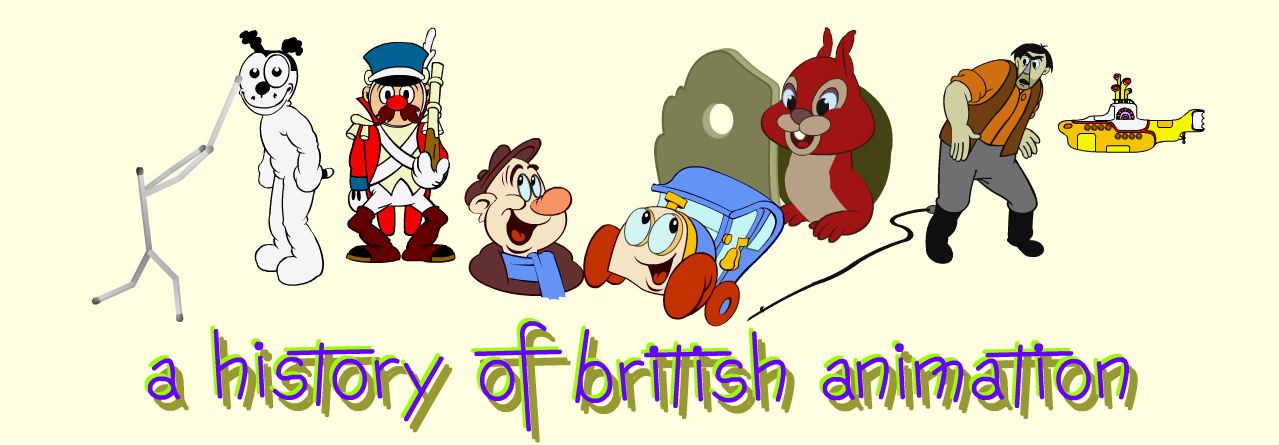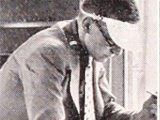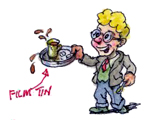

|
 | Carl Giles(1916-1995) |  |
||
|
Ronald Giles was born in Islington on 29 September 1916, the son of Albert Edward Giles, a tobacconist whose father had been a Newmarket jockey, and Emma Edith Clarke, a Norfolk farmer's daughter. He left school in 1930 to work as an office boy at SuperAds, an animation agency in Charing Cross Road. In 1955 animator Laurie Price wrote to Giles, recalling those days. Ken Clark, writing in Animator magazine, tells the story: Laurie Price was one of the professional animators who befriended him in those early days. Years later, while working at Publicity Pictures he saw a photograph of Giles in the newspaper and turning to Chris Millett, he said, “That’s young Giles, who used to be with us.” Chris retorted, “No – never, he’s much too fat!” But Laurie persisted, “It is, it’s him. I’ll prove it.” He wrote to the newspaper and to his great delight received a card bearing a typical Giles cartoon of a little lad (himself) rolling downstairs in a film bin, a pictorial reminder of past rowdy humiliations. Price's letter had begun: This is a 1931 ghost writing to you. Possibly you remember me at that time at SUPERADS in Charing Cross Rd. - with MR ALDERSON, GRIFFITHS, WHITE, Matheson, MILLETT & Uncle Dudley Buxton & all. I showed last Thurs. "Express" photo of yourself (& nurses) to one of the above mentioned ghosts & he took a lot of convincing that it WAS the same Ronnie GILES of our youth. To me, it looked exactly the same Giles (though a size larger) that we used to cram into a film bin. In the letter accompanying the card Giles replied: “Just over 20 years between now and the film days I take the liberty of dropping the Mr. Price. For having successfully dodged all forms of art schools I hold you and the ghosts partly responsible for my basic training, especially in the art of self-defence. Money came easy in those days, Ten shillings a week from Messrs Goodman and Alderson (studio manager) and one-and-a-half pence a cup for filthy tea twice a day from each of you and no tax.” According to The British Cartoon Archive, Giles gravitated from office boy to animation trainee, and was a capable inbetweener by the time SuperAds finally closed its doors on Christmas Eve 1931. He found work as a trainee for another London animation studio, identified by Ken Clark as Younger Films, inbetweening or tracing and painting as required. “That was the best training I could have had”, he said of those days: “They were marvellous places. I’d have worked there for nothing. All those people, some really great artists. You had the chance to see all the various styles - it was absolutely marvellous." In January 1932 the film Frankenstein opened in the UK, and when young Ronnie had a severe (but long overdue) haircut one of the animators likened it to Boris Karloff's portrayal of the monster. The nickname "Karlo" stuck, and Giles retained it, shortened to Carl, for the rest of his life.
By 1935 Giles felt experienced enough to take a job as animator on the first of what Ken Clark says was to be a series of Technicolor cartoons being made at London Film Productions by Anthony Gross and Hector Hoppin, who had been brought from Paris to Elstree on the strength of their 1934 cartoon Joie De Vivre as part of Alexander Korda's dream of including a Hollywood-style animation studio in his British film empire. The animation unit was subsequently moved to premises in Isleworth. Gross and Hoppin led the animation, assisted by Laszlo Meitner, Kathleen Murphy and Carl Giles. Some sources seem to suggest that they shared animation, inbetweening and trace and paint work. The short, The Fox Hunt, was praised by Graham Greene in the Spectator: Undoubtedly the best film of many weeks is the coloured cartoon, Fox Hunt. The artists, Mr. Hector Hoppin and Mr. Antony Gross, use Technicolor with a freedom and beauty quite outside Mr. Disney's picture-book range. A hunt which turns into a mechanised chase, a motorbus playing an agile part; swollen, narcissine, decadent horses preening before gilt mirrors: both theme and drawings have unusual wit, but what remains in the memory is the lyrical use of colour: the white ringletted horse ballooning over the dark box hedges of the little enclosed garden with its classical statue, the rich autumn ruin under hoof, the bypass road lined with gay sublimated posters. However, the film was not a commercial success and the studio was closed. It was at this time that Giles, a keen motorcyclist, had an accident that fractured his skull, impairing his sight and hearing on one side and, more importantly for Giles at the time, damaging his drawing hand. Recuperating in East Anglia, he answered an advertisement “for a professional to train animators and tracers at the Roland Davis studio in Ipswich”. Roland Davis had started to make a serties of shorts starring his newspaper cartoon character the horse “Steve”. Giles worked as chief animator on five Steve films, released in 1937. At the same time, encouraged by Davies' example, he started submitting cartoons to newspapers and magazines, and by the time the series ended he had paved the way to a career as a full-time newspaper cartoonist. On the tragic death of his elder brother Bert, from complications afer injuring his knee at work, Carl returned to London to support his grief-stricken mother, and took a job with Reynolds News, a left-wing Sunday paper. In 1942 he married his cousin, Joan Clarke. They had no children. In late summer 1943 he was pursuaded to move from Reynolds to the Daily Express. He made a brief return to animation during 1943-4, making 3 Ministry of Information shorts for inclusion in Paul Rotha's Worker and War-Front documentary series: A Cautionary Tale, about a man who dies of sepsis after ignoring a scrap-metal cut to his finger; One Pair of Nostrils, where cold germs linger like enemy paratroupers; and Grenade, in which a salvaged kettle becomes a Mills hand grenade, which initially feels inferior to all the more powerful weapons but, on being thrown, not only takes out the enemy field gun but goes on to blow up Goering, Goebbels and Hitler, finally reducing the German eagle to a roast dinner. According to Gifford these were produced by the film editor Lister Laurence, who was a member of the Film Producers Guild production company. In September 1944 the Daily Express sent Giles (unfit for active service due to his motorcycle accident) with their other war correspondents to record the Allied Advance. After the war Carl and Joan moved to Ipswich, where Giles drew his cartoons, sending them to the Express by train or taxi, usually at the very last minute. Giles' only other connection with animation came in 1983 when the Giles "family" featured in a series of TV ads for Tetley Quick Brew tea. The advertising agency Royds had planed the campaign and commissioned Dragon Animation to make the films. Giles was highly protective of his "family", and dismissive of artwork prepared "in his style" by other hands. He insisted that he did all promotional artwork for the print campaign, and that he provide comprehensive key drawings for the films, which caused many deadlines to be missed. He apologised - but would not compromise. The campaign ran until 1987. Giles died in hospital in Ipswich, 27 August 1995, aged 79. His wife Joan had died the year before.
|
Filmography | ||||
| various advertising films | (SuperAds, 1931) Inbetweener | |||
| various advertising films | (Younger Films, c.1933) Inbetweener | |||
| The Fox Hunt | (London Films, 1936) Animator | |||
| Steve Steps Out | (Roland Davies, (1936) Animator | |||
| Steve's Treasure Hunt | (Roland Davies, (1936) Animator | |||
| Steve's Cannon Crackers | (Roland Davies, (1937) Animator | |||
| Steve Of The River | (Roland Davies, (1937) Animator | |||
| Steve In Bohemia | (Roland Davies, (1937) Animator | |||
| A Cautionary Tale | (in Worker & War-Front 8; MOI, 1943) Producer/Animator | |||
| One Pair of Nostrils | (for Ministry of Health; MOI, 1944) Producer/Animator | |||
| The Grenade | (in Worker & War-Front 11; MOI, 1944) Producer/Animator | |||
| The Golf Match (ad for Quick Brew Tea) | (Dragon, 1983) Designer | |||
| Wallpapering (ad for Quick Brew Tea) | (Dragon, 1983) Designer | |||
| The Motor Bike (ad for Quick Brew Tea) | (Dragon, 1983) Designer | |||
| Garden Games (ad for Quick Brew Tea) | (Dragon, 1983) Designer | |||
Links to Other Sites | ||||
Carl Giles: BRITISH CARTOON ARCHIVE: Informative biography and archive of documents at the University of Kent. Carl Giles – A 50 Years Celebration: Article by Ken Clark from the Animator Mag Archive. |
Peter Hale
Last updated 2016
|